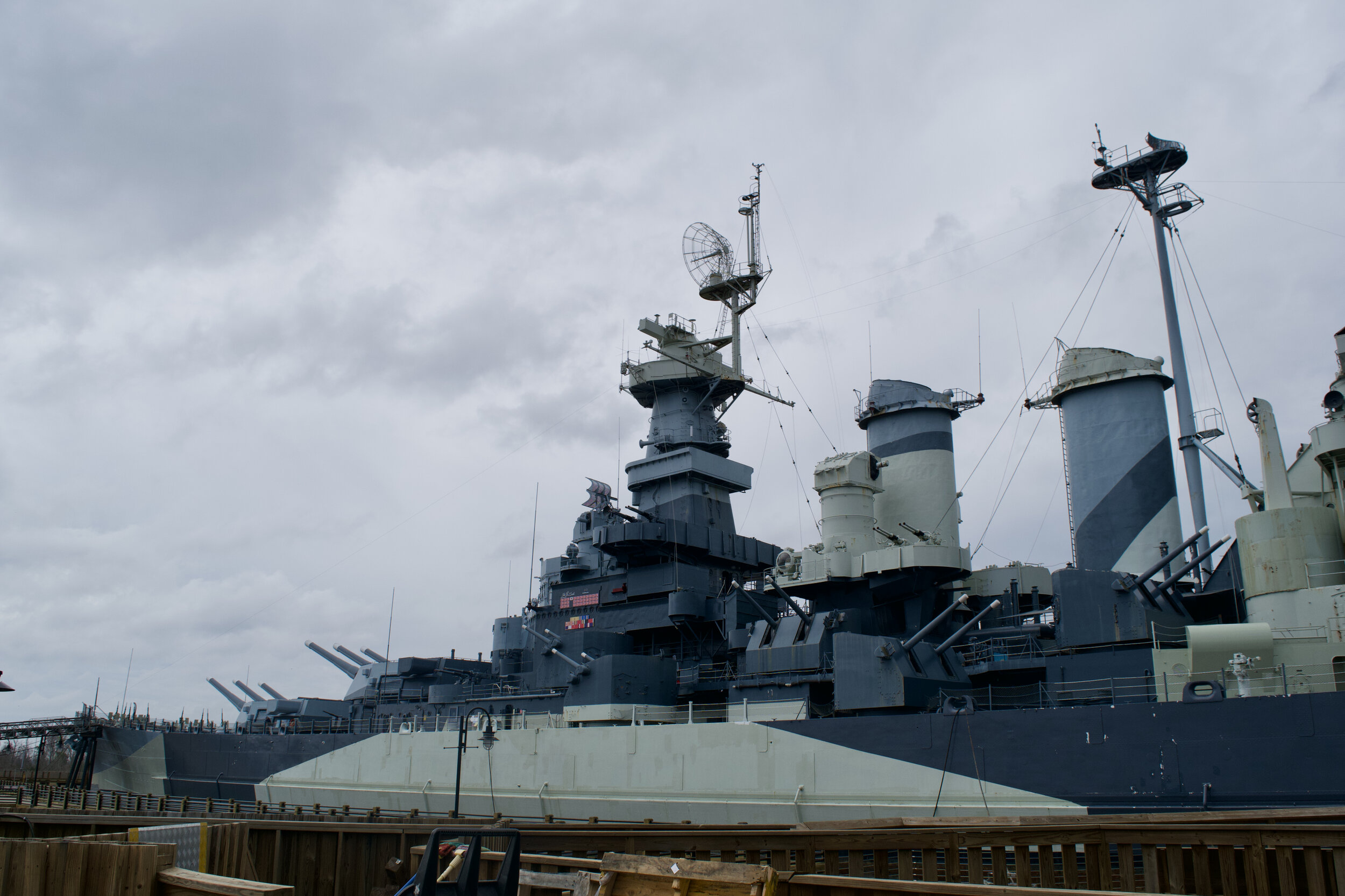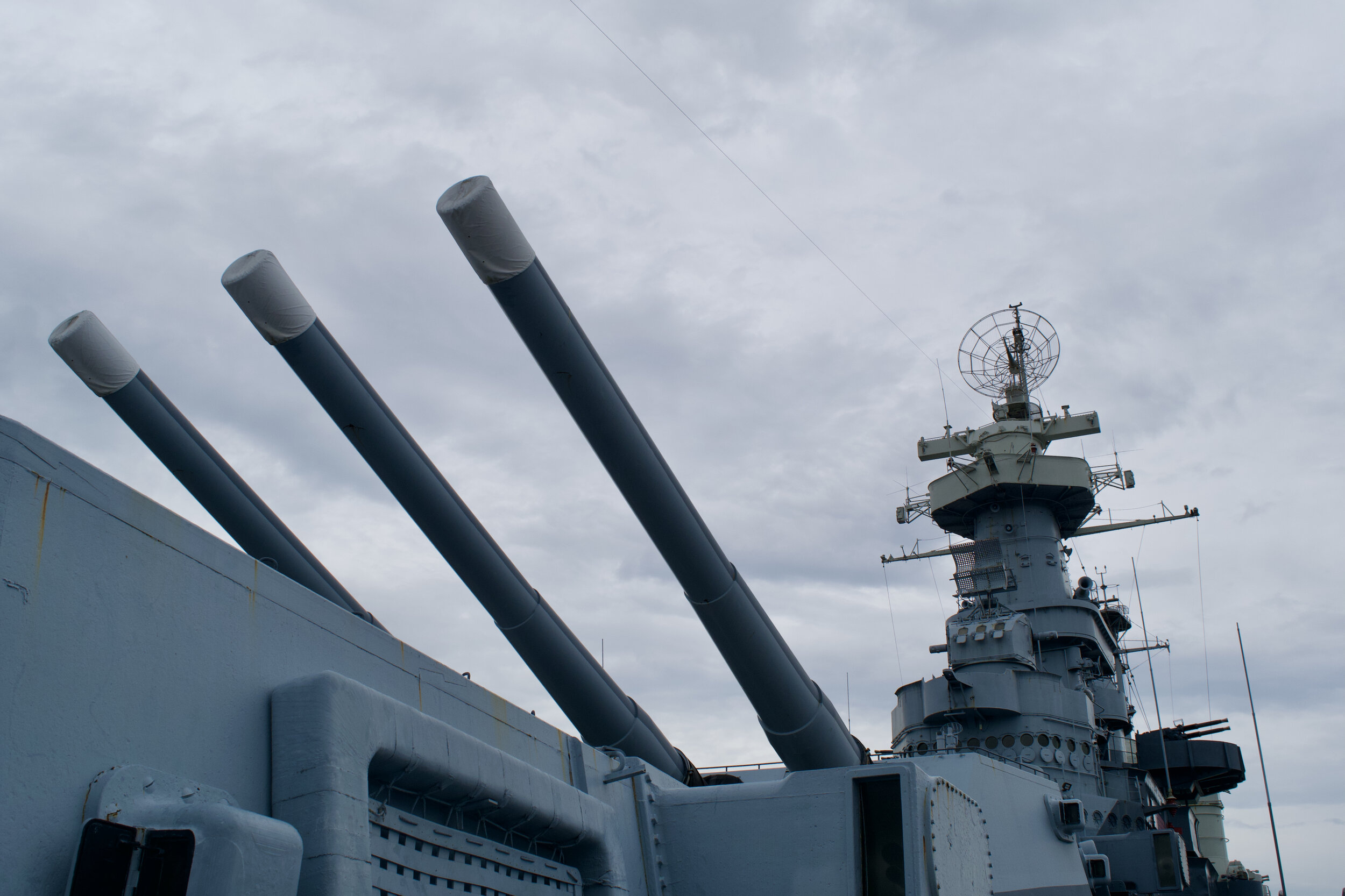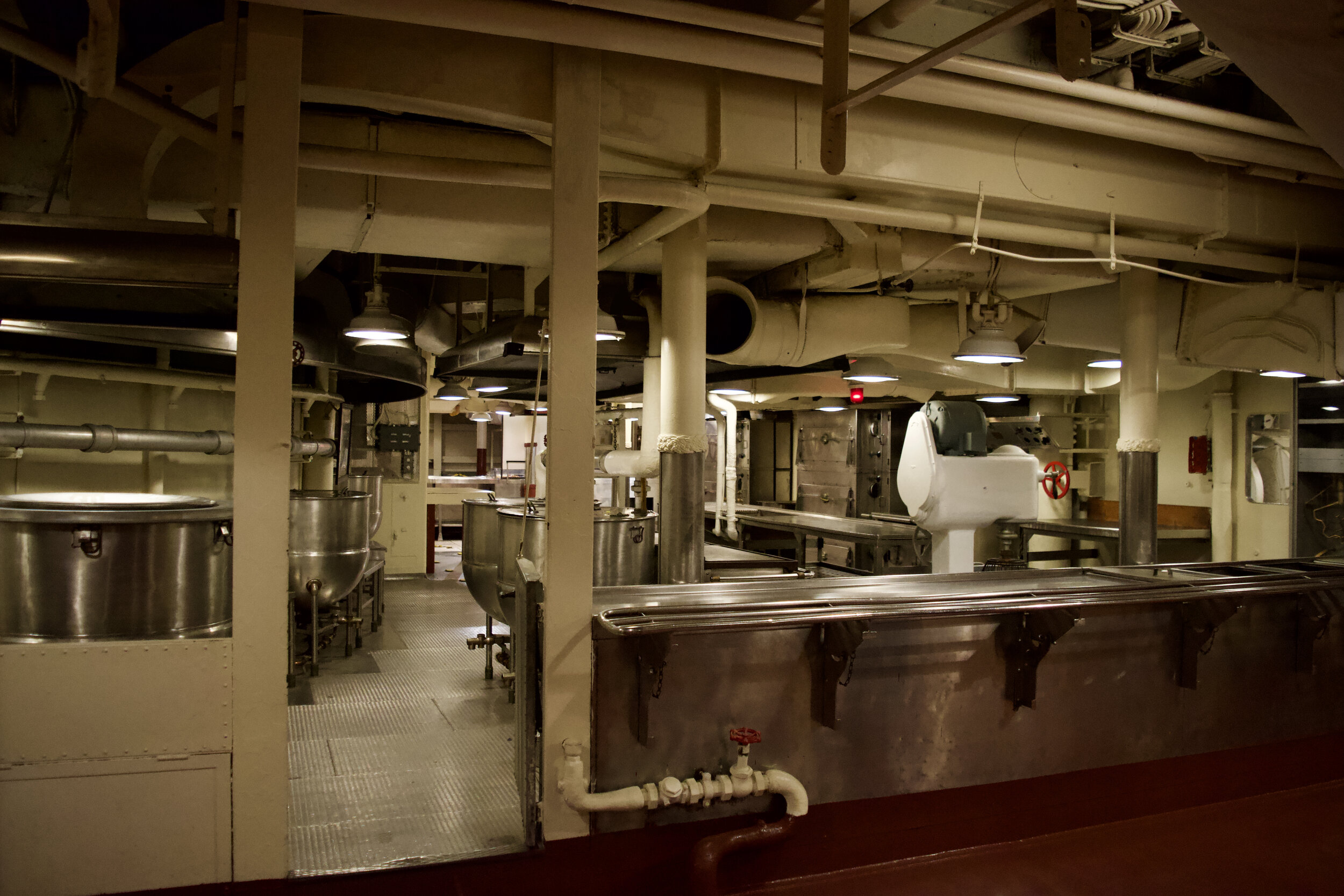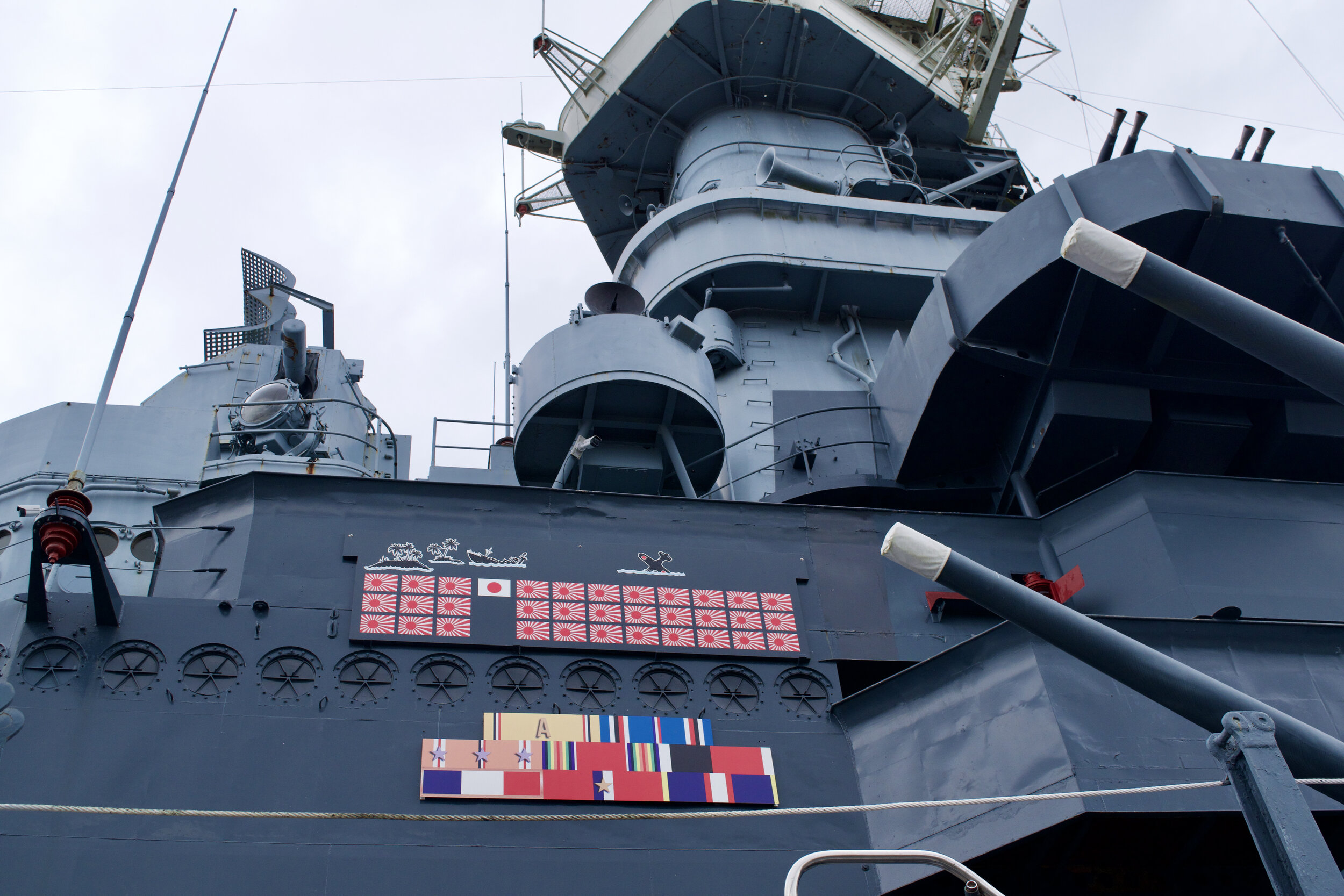Life Aboard a War Ship: Visiting the USS North Carolina
The city of Wilmington, North Carolina sits along the state’s Atlantic coastline. As a small and charming Southern city, Wilmington is known for its riverfront as well as its historic district. However, moored in the Cape Fear River is a distinct part of Wilmington’s riverfront skyline as well as a part of American history -- the battleship known as the USS North Carolina.
The battleship began construction in 1937 at the New York Navy Yard and was commissioned on April 9, 1941. Alongside her sister ship, the USS Washington, the USS North Carolina was a part of the North Carolina class of battleships as well as the first of her kind to join the American fleet in the Second World War. Following the end of the war, she had sailed nearly 300,000 miles and had participated in every major naval operation in the Pacific Theatre -- even surviving a torpedo hit from a Japanese vessel in September 1942. By the time the war ended, the USS North Carolina had earned fifteen battle stars. Out of her crew, only ten men were killed in action and only sixty seven were wounded.
The USS North Carolina as it appears today in Wilmington, North Carolina. The form of camouflage used by the USS North Carolina, a method known as “dazzle camouflage,” is very visible here. It goes without saying that hiding something as large as an entire battleship is next to impossible, which is why dazzle camouflage was conceived. The purpose of this form of camouflage is not necessarily to make the vessel less visible but to make it difficult for those observing a ship to be able to discern how far away it is, how large it is, as well as what direction it is heading in.
After serving in the United States Navy for twenty years, the ship was converted into a museum in 1961 and is open for the public to visit every day of the year except on holidays. Wilmington is easy to access as well, being near several North Carolina beaches and only an hour and a half drive north of vacation hotspot Myrtle Beach, South Carolina. Besides, who wouldn’t want to explore a battleship that fought in the Second World War?
I had the chance to visit the USS North Carolina earlier this month and despite being a student of World War II history, I had no idea what to expect. What I found was a fascinating time capsule through which to view American participation in Pacific theatre of operations. The ship has been restored to resemble what it would have looked like during its service in World War II: the public tour route takes you past its nine 16-inch/45 caliber guns as well as its twenty 5-inch/38 caliber guns. Not only can you view the sheer size of this weaponry but you are able to climb into one of the three turrets housing the 16-inch guns and see for yourself how they were operated by the crew of the USS North Carolina.
One out of the three sets of 16-inch/45 caliber guns aboard the USS North Carolina. While the 5-inch/38 caliber guns provided the ship with an impressive 8 mile range, the 16-inch/45 caliber guns gave the USS North Carolina a whopping 23 mile firing range.
Despite the impressive camouflage scheme and guns of the USS North Carolina, it is well worth it to see what lies below deck. Here one truly gets a glimpse at the life and work of her crew. While we learn about the Second World War and its significant moments in schools, it is hard to grasp or understand the day to day lives of the Americans who fought went overseas to fight it. However, by visiting the USS North Carolina you are able to get a unique glimpse of what daily life was like aboard an American war ship during World War II.
The gallery of the USS North Carolina where meals would be prepared and served for crew members. The giant silver vats pictured could hold up to 80 gallons each, something that would have been extremely useful to feed an entire ship’s crew. The ship’s bakery, which would make bread as well as desserts, would have also been housed in this part of the ship.
A replication of the storage room for vegetables such as potatoes, cabbage, and onions as they would have appeared aboard the USS North Carolina during its time in the Second World War. An effective way to store large quantities of food would have been critical to the success of the USS North Carolina and her crew.
One of the first places I was able to see was the ship’s dining halls and kitchens. Here you can not only learn about the roles they played in the lives of the sailors of the USS North Carolina, but you are able to see the range of infrastructure that was used to keep an entire war ship’s crew fed. However, it is also an excellent look into the daily lives of the sailors that were aboard the ship. For example, you are even able to see the drinking fountains used by the sailors known as scuttlebutts, the term for such installations on a naval vessel. The crew of the USS North Carolina as well as other sailors in the U.S. Navy would often use these water fountains as a place to gather and share gossip. Thus, “scuttlebutt” became slang for gossip and rumors.
The scuttlebutts in the gallery of the USS North Carolina where sailors would have often met for a quick chat or to exchange some gossip.
As you continue to walk through the lower decks of the ship, you’re able to see a series of displays showing the other goods and services that would have been available to the USS North Carolina’s crew. When one thinks about the crew of a war ship, they often forget that it is made up of people who have other needs outside of food and a place to sleep. Each and every member aboard the USS North Carolina required ways to maintain their hygiene, clean clothes to wear, and some form of entertainment for down time. Not only is this illustrated through the displays of clothing, cigarettes, playing cards, toiletries, and more on the USS North Carolina today but these exhibits are also a look back through time showing us what those very basic, simple comforts would have looked like for the ship’s service members during its time in World War II.
A number of goods that would have been available to crew members during the Second World War are on display aboard the ship today including cigarettes, stationery, watch straps, nail filers, shoe shine, laundry detergent, playing cards, and more.
A close up on the postal stationary that would have been available to crew members to write letters for loved ones.
Another important amenity you are able to see under the decks of the USS North Carolina is the Post Office. It goes without saying that in a world without the widely available instantaneous communication we have today, the mail was a vital way for soldiers to stay in touch with their friends and loved ones back home. As a result of this need, V-Mail or “Victory Mail” was created during World War II to not only provide quicker and more efficient postal services for those stationed overseas but to create extra space for other drastically needed supplies aboard transports. The technology that was utilized for V-Mail allowed the United States to keep up with the increased demand for the postal service in a way that was effective for not just those serving in the war and their families but for the overall success of the American war effort.
A mailbox where crew members could have deposited their letters to be sent.
A replication of what the mail room aboard the USS North Carolina would have looked liked during the Second World War.
In addition, the USS North Carolina had a fully equipped with a “sick bay” or in other words, a miniature hospital for those aboard. Living aboard the a vessel such as the USS North Carolina meant that many men were kept in close quarters and disease could spread far more easily. Additionally, being aboard a battleship in a theatre of war would leave one predisposed to certain injuries. As a result, the ship had a fully operational medical center for when crew members fell sick or were wounded. It was even accompanied by a lab for testing medical samples taken from the sailors as well as an operating room in the instance that more serious medical care was required.
The operating room aboard the USS North Carolina as it would have appeared during World War II.
All in all, the crew aboard the USS North Carolina made her come out of the Second World War as an impressive and decorated vessel. She earned fifteen battle stars for the fifteen campaigns she participated in as well as eight battle ribbons for the role she played in the Pacific Theatre of Operations. On top of that, the USS North Carolina and her crew were able to sink one ship, down 24 planes, and bombard the islands of Japan nine separate times. These accomplishments are highlighted by a display of flags and ribbons along the side of the ship today.
The battle ribbons and “kill board” of the USS North Carolina, detailing its storied career in World War II.
A placard detailing the battle ribbons, campaigns, and “kills” of the USS North Carolina’s World War II career.
While there is plenty to see aboard the USS North Carolina today to see with regards to its weaponry and fighting capabilities, the most interesting part of my visit was to see how the Americans on the frontlines of the Second World War went about their lives in such a unique environment. However, if you wish to visit the USS North Carolina to learn more about its military might and gigantic guns, by all means you should! Part of what makes history so wonderful is that there is so much of it to experience and the Battleship North Carolina historical museum in Wilmington allows us to experience history in a way that is not only fun but striking.












